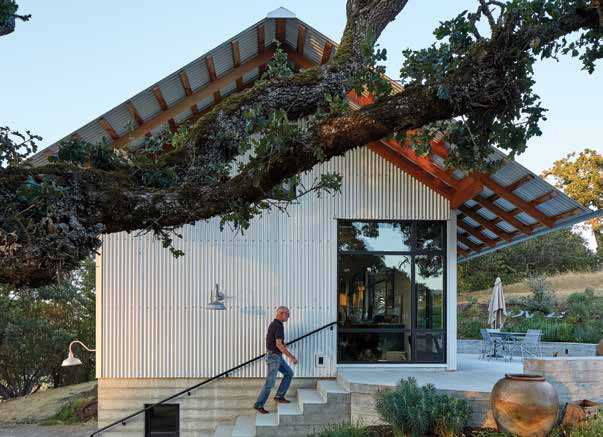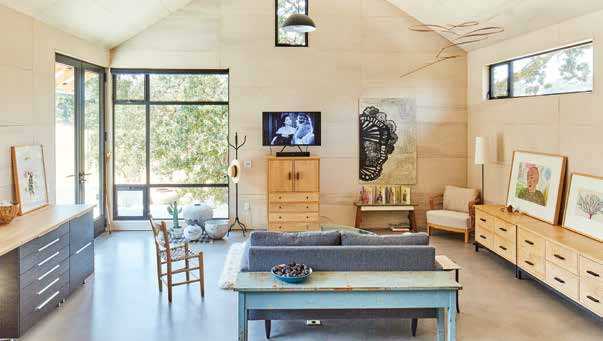A couple of retired graphic artists left the suburbs of Palo Alto, Calif., to live and learn about seasonal shifts and natural processes on a 7-acre parcel in Petaluma, Calif. After planting an orchard and running sheep, they wanted to build a one-room studio that could flex with the needs of the day.
One-room studio apartment is nestled into California hillside

Photo: The Morrisons
The couple turned to Mary Dooley, principal architect and lead designer at MAD Architecture, Petaluma, to design a 760-square-foot studio house with a two-person office, living room that would seat six, and an eight-person dinner party space that converts into a bedroom with a Murphy bed for two each evening. Downstairs there’s a garage, laundry and store. This residence will become a secondary unit when the main house, currently under construction, is completed.

Photo: The Morrisons
An Undisturbed Landscape
Rather than expanding into undeveloped terrain, the residence—known as Red Hill Studio—is built on the site of a demolished farmworker house. Formed into the hillside and nestled between oak trees, the studio maintains the stewardship of the land by building within the disturbed area. Mature oaks and rolling hills covered with native grasses make up the surrounding landscape, while a water tank and moss-covered chicken coop stand as reminders of earlier times. Throughout the week, the sunlight and fog patterns constantly change.
As Dooley notes, the importance of where to best hunker down was born during the first client meeting that was blasted by a coastal wind from the Petaluma Gap. “The Petaluma Gap is a low point from the coast to east of Highway 101 that is essentially a coastal wind tunnel that cools the low lands and blows in the coastal fog from the Pacific Ocean and Bodega Bay,” she says.
By serving as a windbreak, the house is also a noise barrier and visual screen from the road activities. “There could be a private world from the house and patio looking southeast to southwest and all country—no cars, no pavement,” Dooley says. “A quiet face to the road included a board-formed concrete garage and entry with minimal punctuation for access and passive cooling—enough to provide a sense of life at the studio at night.”
According to Dooley, the orientation for the studio was driven by five factors: tree protection, solar access, noise, wind and privacy. All of these factors were accommodated within the bounds of the previous homesite, and then fine-tuned throughout the design and construction process.
As such, the siting for the home allows the owners to walk level out the door to the patio and onto the grasslands. “The curved patio softens the connection to the uphill grasslands,” she says. Additionally, the oak grove and the chicken coop played a factor in where the windows were placed.

Photo: The Morrisons
A Simple Design Palette
The architecture for Red Hill Studio looks through a farmer’s eyes for its materials and assembly, Dooley says. This is achieved by turning a quiet face to the busy road, finding shelter from the coastal winds, and establishing friendly relations with trees, grass and sun.
As a guide to the home’s simplicity over complexity, Dooley notes they asked the question, “What would the farmer do?” And, “By using corrugated metal on the roof and walls, we kept a simple palette that seemed to fit into the site,” she says.
Where the home is located in rural Marin County, corrugated metal has been the historic metal siding and roofing material of choice. For example, the original chicken coop located behind the house has a rusting metal roof that has lasted more than 100 years.
By using a timeless gable form and the simple material palette, the structure feels like it was always there. “Creating tight cladding details for the corrugated metal, metal windows, corners and hems atop a board-formed concrete garage, the craft was upgraded beyond utilitarian,” Dooley says.
When designing the roof, Dooley notes there was an opportunity for a little shift. At the entry stair, the roof extends like a brim of a cap as weather protection from the concrete stair to the front door. This leaves the cedar structure and the underside of the metal roofing exposed. The gutter runs past the end of the roofing for another 4 feet, creating drama that can be watched from inside during a rain storm.
To match the area’s historic style, Red Hill Studio features 850 square feet of Salem, Ore.-based Taylor Metal Products’ 24-gauge Classic 7/8-inch corrugated metal panels with an AZ50 ZINCALUME coating from Steelscape LLC, Kalama, Wash. “This is a cost-effective, maintenance-free material that made perfect sense for the design intent,” she adds.
The simple, one-room Red Hill Studio achieves its goal of making a big impact with a small footprint. MAD Architecture received the 2018 AIA Redwood Empire Honor Award for Residential Design for its unique design.





